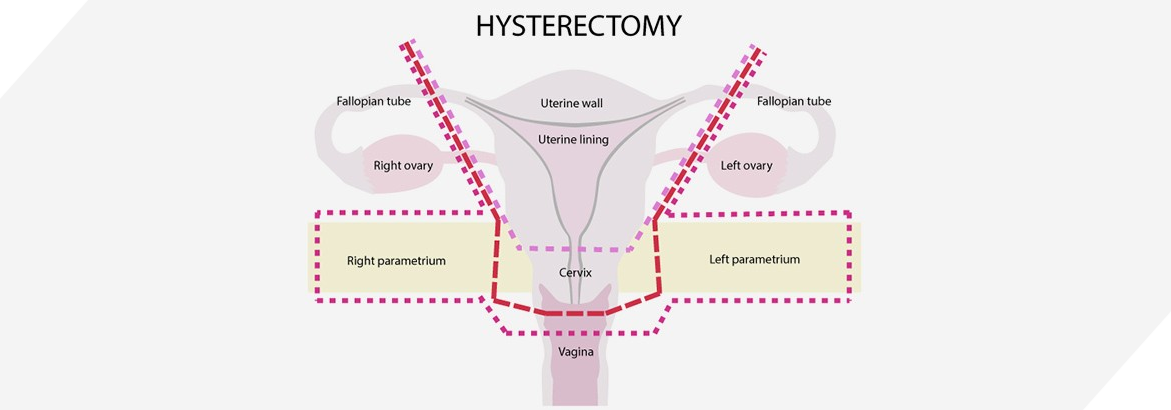Robotic-Assisted Hysterectomy (A new option for uterus removal)
Many benign (non-cancerous) conditions can affect a woman’s reproductive system, which includes the uterus, vagina, ovaries and Fallopian tubes but mostly affect the uterus (the hollow, muscular organ that holds a baby as it grows inside a pregnant woman).
A hysterectomy is the surgery to remove your uterus and is used to treat common benign conditions such as:
- Uterine fibroids (Abnormal growth of endometrial tissue outside the uterus)
- Endometriosis (non-cancerous growths of the uterine lining)
- Uterine prolapse (the falling or slipping of the uterus into or out of the vagina)
- Abnormal uterine bleeding (that does not improve with medical treatment)
- Chronic pelvic pain (due to adenomyosis or endometriosis)

Q: |
What are the surgical options available for removal of uterus (hysterectomy)? |
A: |
Hysterectomy can be done with open surgery or minimally invasive surgery (Laparoscopy or robotic assisted) |
Q: |
How long does a robotic assisted prostatectomy surgery take? |
A: |
The actual procedure normally takes three hours, depending on the patient's anatomy and the extent of surgery, which may take longer. |
Q: |
What is Open Surgery (Abdominal Hysterectomy)? |
A: |
Traditionally, abdominal hysterectomies are performed with open surgery, which requires a wide incision below the navel. This procedure can be painful, involving heavy pain medications, risk of infection and significant blood loss. After surgery, a long recovery (often 6 weeks) is necessary. In addition, many patients are not happy with the scar left by the incision. |
Q: |
What is Vaginal Hysterectomy? |
A: |
Surgery is done through a cut in your vagina. The surgeon takes your uterus out through this incision and closes it with stitches. However, when the uterus is large or if you have internal scarring from prior surgery or other conditions, the vaginal route may not be suitable. |
Q: |
What is Laparoscopic Hysterectomy? |
A: |
With traditional laparoscopy, your surgeon operates through a few small incisions in your abdomen using long instruments and a tiny camera. The camera sends images to a video screen to guide doctors during surgery. |
Q: |
What is Robotic Assisted Hysterectomy (da Vinci Hysterectomy)? |
A: |
The surgeon operates through just a few small incisions in the abdomen, just like traditional laparoscopy, but the surgery is assisted with a robotic surgical system, the da Vinci Surgical System. |
Q: |
How long does a robotic assisted hysterectomy surgery take? |
A: |
The actual procedure normally takes less than an hour to 2 hours, depending on the patient's anatomy and the extent of surgery, which may take longer. |
Q: |
How long will I have to stay in the hospital after surgery, and when can I resume normal activities? |
A: |
Most robotic hysterectomy patients are able to go home 2 to 3 days after surgery. Most patients are allowed to return to work after 10-20 days depending on the type of job. |
Q: |
What are the potential benefits of robotic assisted hysterectomy? |
A: |
|
Q: |
Risks & considerations related to Hysterectomy for benign condition? |
A: |
Risks of surgery apply to any types of operation which is not limited to robotic surgery and every care is taken to minimise these risks. Common complications include injury to the ureters (ureters drain urine from the kidney into the bladder), vaginal cuff problems (infection, hematoma, incision opens or separates), injury to bladder (organ that holds urine), bowel injury, vaginal shortening, problems urinating (cannot empty bladder, urgent or frequent need to urinate, leaking urine, slow or weak stream), abnormal hole from the vagina into the urinary tract or rectum. Uterine tissue may contain unsuspected cancer. The cutting or morcellation of uterine tissue during surgery may spread cancer, and decrease the long-term survival of patients. |
Q: |
What are the patient criteria for robotic assisted hysterectomy? |
A: |
Not all patients are suitable for robotic surgery. Severe medical problems and/or advanced age may mean that the patient cannot tolerate the special positioning and length of the procedure. Severe obesity is a common limitation, although robotic surgery can sometimes be successful when standard laparoscopy is not feasible. Severe intra-abdominal adhesions due to previous surgery may prevent a minimally invasive approach. Treatment options should be discussed with your consultant to help you decide the best course of action. |







